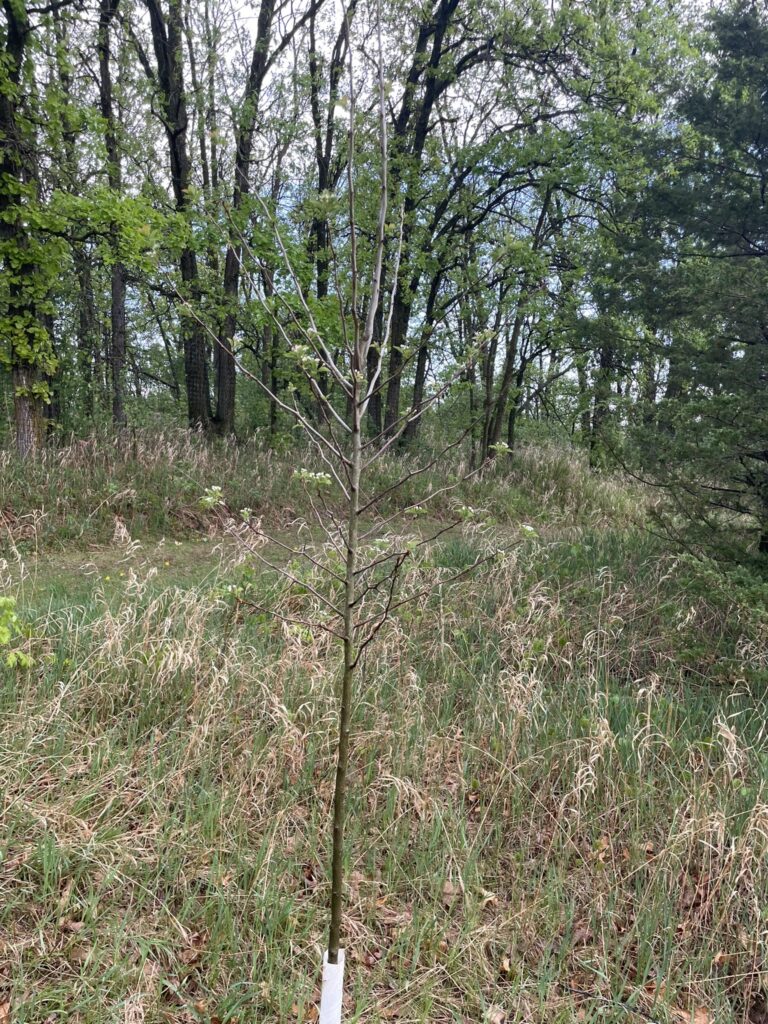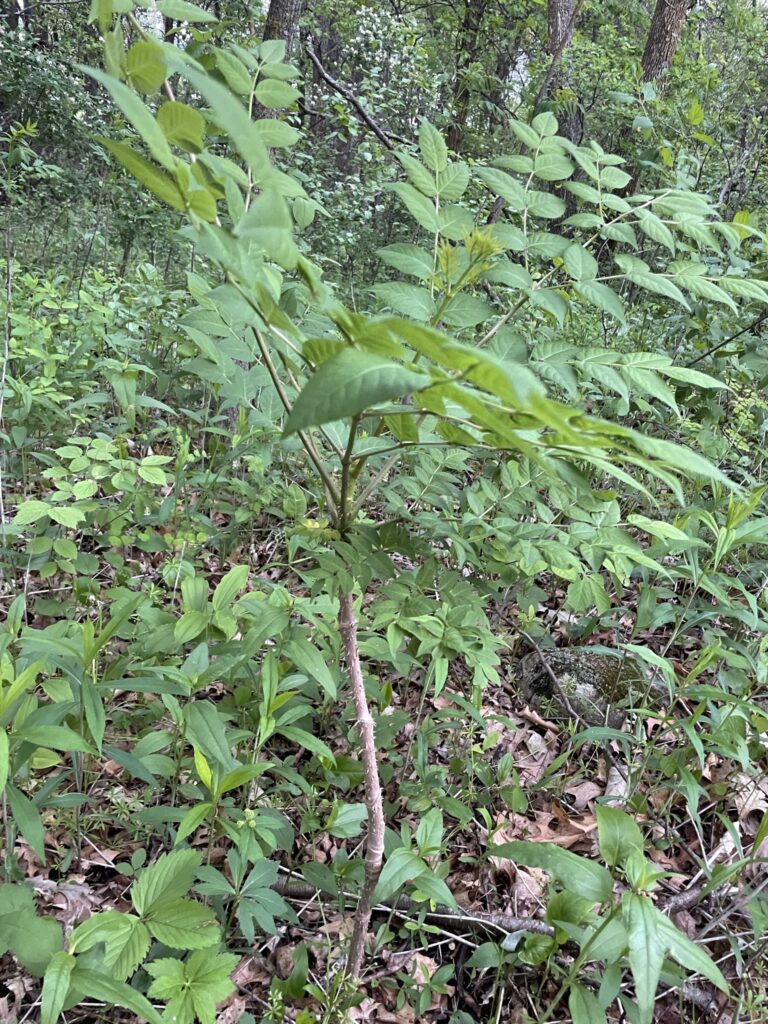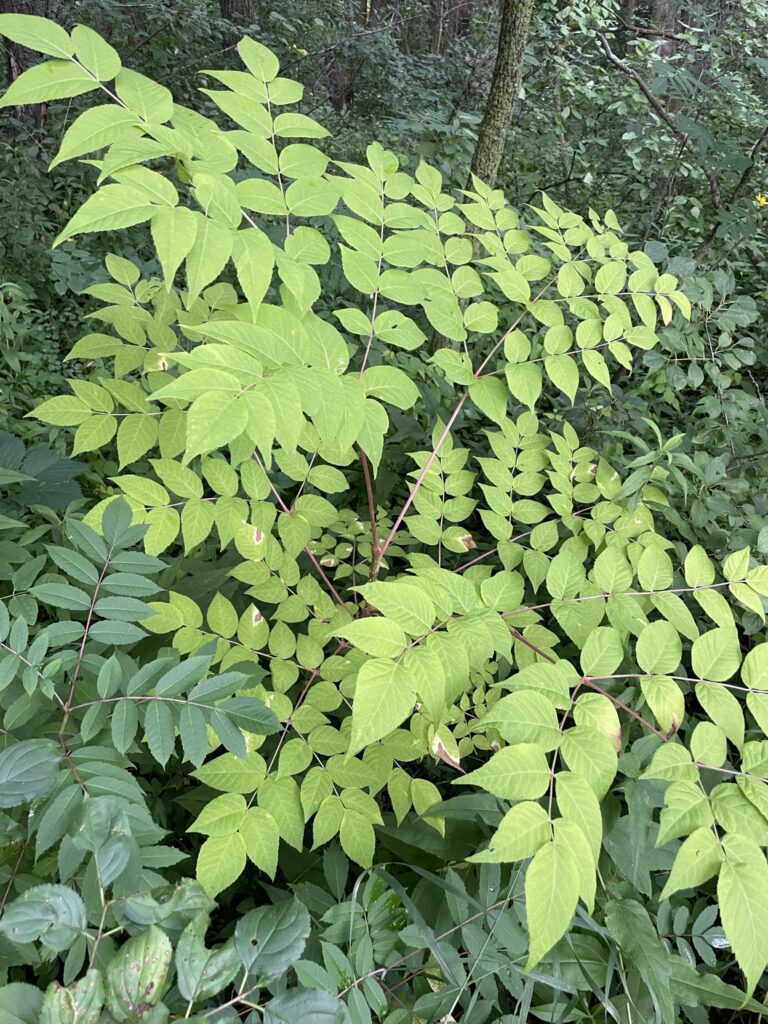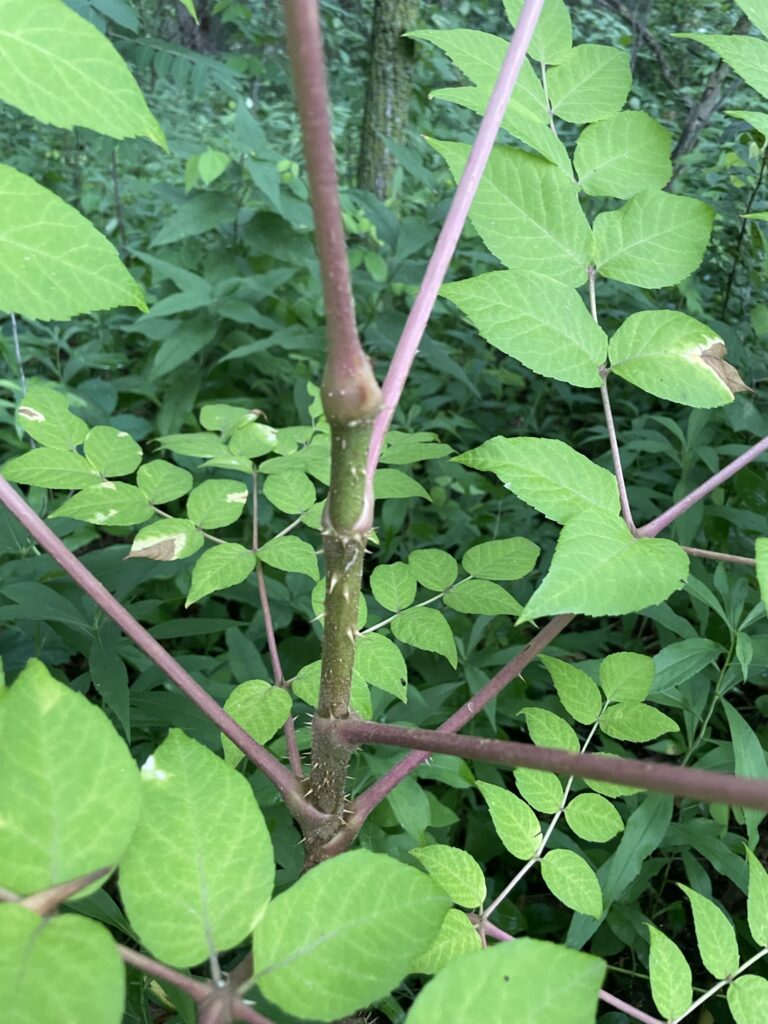
Winter King Hawthorn (Crataegus viridis ‘Winter King’)





Native To State: NO
Naturally Occurring: NO
Description
Spine-covered stem with very large compound leaves at the top.
Distribution: Eastern North America.
Occurrence
Planted in large deer exclosure
Native To State: YES
Naturally Occurring: NO
Description
Appearance: Staphylea trifolia is a deciduous shrub known for its compound leaves and inflated, papery seed pods.
Leaves: The leaves are compound, with three leaflets arranged in a whorl.
Flowers: The plant produces small, bell-shaped, white flowers in drooping clusters.
Fruit: The distinctive feature of this plant is its papery, bladder-like seed pods.
Habitat: It is commonly found in woodlands and along stream banks.
Distribution: American bladdernut is native to eastern North America.
Occurance
Several planted in former pasture area
Native To State: YES
Naturally Occurring: NO
Description
Appearance: Sorbus decora is a deciduous tree known for its pinnately compound leaves and clusters of red berries.
Leaves: The leaves are pinnately compound with serrated leaflets.
Flowers: The plant produces clusters of white flowers.
Fruit: It bears clusters of bright red berries that persist into late fall.
Habitat: It is commonly found in moist woodlands and mountainous regions.
Distribution: Northern mountain ash is native to northern North America.
Occurance
Several planted near the big brush island
Native To State: YES
Naturally Occurring: NO
Description
Appearance: Celtis occidentalis is a deciduous tree known for its serrated leaves and small, berry-like fruits.
Leaves: The leaves are serrated, elliptical to lance-shaped, and alternate along the stem.
Fruits: The plant produces small, round, berry-like fruits that turn dark purple when ripe.
Habitat: It is commonly found in a variety of habitats, including woodlands and open areas.
Distribution: Common hackberry is native to North America.
Occurrence
Many seedlings planted in various places in 2016
Native To State: NO
Naturally Occurring: NO
Description
Catalpa ovata is a deciduous tree belonging to the Bignoniaceae family. It is commonly known as Chinese catalpa or Chinese cigar tree. Here are some key identification characteristics:
Size and Shape: Chinese catalpa is a medium-sized tree that typically reaches heights of 30 to 60 feet (9 to 18 meters). It has an upright, rounded crown with a slightly irregular shape.
Leaves: The leaves of Catalpa ovata are large, heart-shaped, and arranged in an opposite pattern on the branches. They have a glossy green surface and are between 4 to 8 inches (10 to 20 centimeters) in length.
Flowers: The tree produces showy, trumpet-shaped flowers that are white with purple or yellow markings. The flowers are arranged in clusters and have a sweet fragrance. They bloom in late spring or early summer.
Fruit: Chinese catalpa develops long, slender, cylindrical seed pods that resemble cigars, giving it the nickname “cigar tree.” The pods can be up to 20 inches (50 centimeters) long and contain numerous small seeds.
Bark: The bark of young Chinese catalpa trees is relatively smooth and grayish-brown, becoming more ridged and furrowed as the tree matures.
Habitat: Catalpa ovata is native to China and can be found in various regions of Asia. It is often grown as an ornamental tree in parks, gardens, and along streets in other parts of the world.
Cultivation: Chinese catalpa is valued for its unique and attractive appearance, including its large leaves, showy flowers, and cigar-like seed pods. It is cultivated in various countries for its ornamental value.
Other Species: There are other catalpa species, such as Catalpa bignonioides (Southern catalpa) and Catalpa speciosa (Northern catalpa), which are also popular ornamental trees.
Chinese catalpa is appreciated for its ornamental features, making it a sought-after choice for landscaping and urban planting. Its large leaves and eye-catching flowers and seed pods add a distinctive touch to outdoor spaces.
Occurrence
Planted along field trail in 2024. One specimen planted near barn yard in approximately 2009
Native To State: NO
Naturally Occurring: NO
Description
Gleditsia triacanthos f. inermis (Thornless Honeylocust) is a deciduous tree belonging to the Fabaceae family. Here are some key identification characteristics:
Size and Shape: Thornless honeylocust is a medium to large-sized tree, typically reaching heights of 40 to 70 feet (12 to 21 meters). It has an open, spreading canopy with delicate, feathery foliage.
Leaves: The leaves of Gleditsia triacanthos f. inermis are pinnately compound and alternate along the branches. Each leaflet is small and elongated, giving the foliage a fern-like appearance. The leaves are bright green during the growing season and turn golden-yellow in the fall.
Thorns: Unlike the typical species (Gleditsia triacanthos), this variety is “inermis,” which means it is thornless. As such, you won’t find the long, sharp thorns that are characteristic of the species.
Bark: The bark of young thornless honeylocust trees is relatively smooth and grayish-brown, gradually becoming rougher with age and developing ridges and furrows.
Flowers: The tree produces small, inconspicuous greenish-yellow flowers in the spring. The flowers are typically not showy but are important for pollination.
Fruit: Thornless honeylocust bears long, flat, and twisted seed pods (legumes) that are 6 to 18 inches (15 to 45 centimeters) in length. The pods mature in late summer to early fall and turn brown. They persist on the tree throughout the winter.
Habitat: This variety is often planted as an ornamental tree in urban and residential areas due to its attractive appearance and thornless nature. It can tolerate a wide range of soil conditions and is relatively drought-tolerant once established.
Cultivation: Thornless honeylocust is widely planted for its aesthetic value, providing filtered shade in landscapes and streetscapes.
Other Species: It’s essential to differentiate this thornless variety (f. inermis) from the typical species (Gleditsia triacanthos) that does have thorns.
Thornless honeylocust is favored for urban landscapes and other settings where thorns might pose a concern. Its delicate foliage and absence of thorns make it an appealing choice for those seeking a low-maintenance and visually pleasing tree.
Occurrence
One large specimen planted near barn in 2008.
Native To State: NO
Naturally Occurring: NO
Description
Appearance: Catalpa speciosa is a deciduous tree known for its large, heart-shaped leaves and showy, trumpet-shaped white flowers.
Leaves: The leaves are large, heart-shaped, and typically clustered at the branch tips.
Flowers: It produces showy, white, trumpet-shaped flowers.
Fruit: The tree bears long, slender pods containing seeds.
Habitat: It is commonly found in a variety of habitats, including woodlands and urban areas.
Distribution: Northern catalpa is native to North America.
Occurrence
One specimen planted along farm yard driveway.
Native To State: NO
Naturally Occurring: NO
Description
Appearance: Phellodendron amurense is a deciduous tree known for its pinnately compound leaves and small yellow flowers.
Leaves: The leaves are pinnately compound, with several leaflets.
Flowers: It produces small, yellow flowers in clusters.
Bark: The bark is corky and rough.
Fruit: It produces small, black drupes.
Habitat: It is commonly found in various habitats, including woodlands and urban areas.
Distribution: Amur cork tree is native to eastern Asia.
Occurrence
Two mid-sized specimens in the farm yard and seedlings planted along east side of property in 2017.
Native To State: YES
Naturally Occurring: YES
Description
Appearance: Ostrya virginiana is a deciduous tree known for its slender, serrated leaves and hop-like fruit clusters.
Leaves: The leaves are alternate, serrated, and resemble those of birch trees.
Fruit: It produces hop-like clusters of seed pods.
Bark: The bark is grayish-brown and develops a shaggy appearance with age.
Habitat: It is commonly found in woodlands and along streambanks.
Distribution: American hophornbeam is native to North America.
Occurrence
Widely occurring in the understory of woods in the formerly pastured areas.